Portable Coded-Aperture Raman Spectrometers

- Portable, Automatic Raman Shift Measurements & Analysis
- 785 nm Excitation Laser for Fingerprint Region
- Includes Database of Common Chemicals
- Built-In Automatic Calibration
RASP2
Raman Spectrometer with
680 nm & 785 nm Lasers
Application Idea
Spectrometer Sample Compartment Lid Raised to Show Select Accessories Included with RASPA1 Kit (Multi-Purpose Holder, Cuvette Insert, and Cuvette)
RASPA1
Sample Accessories Kit

Please Wait
| Key Specificationsa | ||
|---|---|---|
| Excitation Beam Diameterb | 2.0 mm | |
| Signal-to-Noise Ratio (SNR)c | 700:1 (Typical) >300:1 (Min) |
|
| Detection Range(s) |
RASP1 | 500 to 1800 cm-1 @ 785 nm Excitation |
| RASP2 | 500 to 1800 cm-1 @ 785 nm Excitation 2600 to 3700 cm-1 @ 680 nm Excitation |
|
| Spectral Resolution (FWHM) |
RASP1 | <9.7 cm-1 @ 500 cm-1 <7.8 cm-1 @ 1800 cm-1 |
| RASP2 | <9.7 cm-1 @ 500 cm-1 <7.8 cm-1 @ 1800 cm-1 <9.7 cm-1 @ 2600 cm-1 <7.8 cm-1 @ 3700 cm-1 |
|
| Slit Width (Aperture Size) | 2.3 mm x 3.2 mm | |
Features
- Portable Raman Spectrometers
- Ø2.0 mm Beam Diameter Enables Large-Field-of-View for Inhomogeneous Samples
- Internal Laser(s) for Fingerprint Region and High Frequency Region
- RASP1 Spectrometer: Fingerprint Region (500 to 1800 cm-1)
- RASP2 Spectrometer: Fingerprint Region and High Frequency Region (2600 to 3700 cm-1)
- Large 2.3 mm x 3.2 mm Coded-Aperture Input (See Coded Aperture Tab for Details)
- Factory-Calibrated Intensity Using NIST Standard; Polystyrene Chip and Internal Neon Lamp for Wavelength/Wavenumber Calibration
- Record and Analyze Spectra with ThorRaman Software (See Software Tab)
- Sample Composition Analysis Performed Automatically Against Up to Four Substances
- Example Substance Library Included
- Supports Easy Creation of Custom Libraries
- RASPA1 Accessory Kit (Available Separately) Includes Sample Containers and Positioners for Optimal Raman Scattering
Applications
- Identification of Unknown Substances
- Analysis of Chemical Composition
- Quality Control in Pharmaceuticals, Food, Etc.
- Periodic Monitoring of Chemical Processes at Production Sites
Thorlabs' Portable Raman Spectrometers incorporate our innovative Coded-Aperture (CODA) Technology, giving them each a sampling area of approximately Ø2 mm. This makes them ideal for investigating inhomogeneous samples since the measurement is averaged over this area. CODA technology also enables the use of low laser power density at the sample and a high signal-to-noise ratio (700:1). Refer to the Coded Aperture tab for more information. Our RASP1 spectrometer incorporates a 785 nm laser to analyze the chemical structure in the fingerprint region (500 to
1800 cm-1), while our dual-laser RASP2 spectrometer analyzes both the fingerprint (500 to 1800 cm-1) and high frequency regions (2600 to 3700 cm-1).
In comparison to traditional slit spectrographs, these spectrometers average Raman photons from a larger sampling volume, making them ideal for analyzing complex mixtures. The measured spectra are combinations of the emission spectra (fluorescence, Raman, etc.) of all molecules in the sample volume. By evaluating linear combinations of up to four spectra from a pre-recorded database and varying the ratio between them, the measured spectra are approximated to determine a likely composition of the sample. Users can use the software and spectrometer to create their own substance libraries in minutes. The laser wavelength(s) are calibrated using the included RPC polystyrene chip, and spectrograph performance is verified using an internal neon lamp.
The RASPA1 Sample Accessory Kit is available separately and includes assorted fused silica or synthetic quartz glass sample containers and holders that align the samples for optimal Raman scattering and detection. The container holder, cuvette holder, and powdered sample funnel included with the kit are made of robust polyamide PA 2241 FR. Additional sample containers are also available separately.
Software
The ThorRaman Software is used to record Raman spectra and analyze them against libraries of sample molecules; samples can be analyzed for up to four constituent molecules at a time. An example library is included and custom libraries can be created using the software. The substances in the example library include thorough documentation such as acquisition parameters and date of last system calibration. Baseline subtraction and acquisition parameters like exposure time (typically 1 to 20 s) are automated by the software for ease of use. For more information on the Raman software suite, please see the Software tab.

Click to Enlarge
The ThorRaman Software allows for easy acquisition of Raman spectra and includes automatic analysis features. Shown here is a fingerprint region spectrum of calcium fluoride from the example library (blue line) overlaid on the measured spectrum of a calcium fluoride sample acquired using the RASP1 spectrometer (red line).
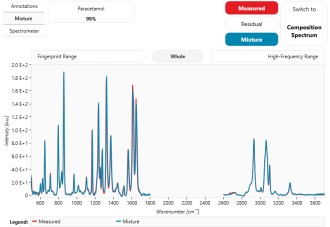
Click to Enlarge
Paracetamol (acetaminophen) is a common drug for reducing fever. Shown here are fingerprint and high frequency region spectra of paracetamol: the blue lines represent the attributed substance from the example library and the red lines represent the measured spectra acquired using the RASP2 spectrometer.
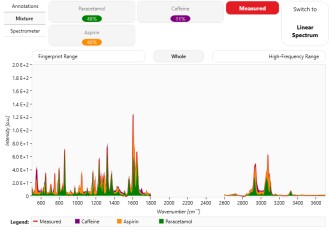
Click to Enlarge
Spectral analysis shows the assignment of the measured peaks to the components of the selected library. Samples can be analyzed for up to four constituent substances.
| Item # | RASP1 | RASP2 |
|---|---|---|
| System Specifications | ||
| Signal-to-Noise Ratio (SNR)a | 700:1 (Typical) >300:1 (Min) |
|
| Excitation Beam Diameterb | 2.0 mm | |
| Optical Specifications | ||
| Excitation Laser Wavelength (Spectral Bandwidth) |
785 nm ± 0.5 nm (<0.2 nm) |
680 nm ± 0.5 nm 785 nm ± 0.5 nm (<0.2 nm) |
| Laser Output Power (785 nm Laser) at the Laser Output Aperturec |
~300 mW | |
| Laser Output Power (680 nm Laser) at the Laser Output Aperturec |
N/A | ~150 mW |
| Slit Width (Aperture Size) | 2.3 mm x 3.2 mm | |
| Detection Range (Wavelength) | 815 nm to 915 nm | |
| Detection Range (Wavenumber) @ 785 nm Excitation |
500 cm-1 to 1800 cm-1 | |
| Detection Range (Wavenumber) @ 680 nm Excitation |
N/A | 2600 cm-1 to 3700 cm-1 |
| Spectral Resolution (FWHM, Wavelength) | <0.65 nm 0.54 nm (Typical) |
|
| Spectral Resolution (FWHM, Wavenumber) @ 785 nm Excitation |
<9.7 cm-1 @ 500 cm-1 <7.8 cm-1 @ 1800 cm-1 |
|
| Spectral Resolution (FWHM, Wavenumber) @ 680 nm Excitation |
N/A | <9.7 cm-1 @ 2600 cm-1 <7.8 cm-1 @ 3700 cm-1 |
| Spectral Accuracy (Wavelength) | ±0.15 nm | |
All technical data are valid at 23 ± 5 °C and 45 ± 15% relative humidity (non-condensing).
| Common Specifications | |
|---|---|
| Intensity Calibration (Factory) | |
| General Intensity Calibrationa | NIST SRM 2241 |
| Wavelength/Wavenumber Calibration (Factory & Customer) |
|
| Spectrograph Wavelength Calibration (nm) | Internal Neon Lamp |
| Laser Wavelength Calibration (cm-1) Conversion via Calibration Chip |
RPC Polystyrene Chip (Included) |
| Grating | |
| Type | Transmission |
| Line Density | 1624 Lines/mm |
| Center Wavelength | 871 nm |
| Diffraction Efficiency (@ Center Wavelength) | >80% |
| Camera/Sensor Specifications | |
| Sensor | Monochrome CMOS, Non-Cooled |
| Effective Number of Pixels (H x V) | 4096 x 2160 |
| Imaging Area (H x V) | 14.131 mm x 7.452 mm (0.56" x 0.29") |
| Pixel Size | 3.45 µm x 3.45 µm |
| Analog-to-Digital (ADC) Resolution | 12 Bits |
| General Specifications | |
| Material of Sample Window | Fused Silica, AR Coated |
| Power Supply | DS12, 12 V |
| Interface to PC | Hi-Speed USB 3.0 |
| Dimensions (L x W x H) | 296.7 mm x 190.2 mm x 127.7 mm (11.68" x 7.49" x 5.03") |
| Weight | 4.6 kg |
| Ambient Operating Temperature Range | 10 °C to 35 °C |
| Storage Temperature Range | 0 °C to 55 °C |
ThorRaman Software for RASP Series Spectrometers
RASP Series Raman Spectrometers require our ThorRaman software package for operation. This software features a straightforward, intuitive, responsive interface that exposes all functions in one or two clicks. Click the software link below (left) to download the latest version of the ThorRaman Software package.
| Recommended System Requirements | |
|---|---|
| Operating System | Windows® 10 (64-Bit) |
| Processor (CPU) | Intel Core i5 or Higher, >2.4 GHz |
| Memory (RAM) | 4 GB |
| Graphic Card Resolution (Min) | 1024 x 768 Pixels |
| Hard Drive (Min) | 64 GB of Available Space (SSD >256 GB Recommended) |
| Interface | Free High-Speed USB 3.0 Port |
ThorRaman Software Highlights
The text below summarizes several key features of the ThorRaman software. Complete details on the software are available in the manual (PDF link).
Raman Scattering Measurements
ThorRaman software is used to perform calibration and adjustment steps, measure Raman scattering, manage substance libraries, and analyze spectra for component substances. Calibration reports, spectra, and libraries can be exported using the software. Exported spectra can also be viewed using ThorSpectra software.
Built-In Tools for Spectral Analysis
Measured Raman spectra can be analyzed for up to four selected component substances from the included example library or from custom libraries created by the user. The measured spectra can be displayed along with combined spectra of the modeled substances from the library, as well as the residuals (the signal which can not be modeled by the selected library).
Substance Library Management
An example substance library is included with the software and custom libraries can be built using spectra acquired by the user. Libraries can be exported for use on other computers with the ThorRaman software.
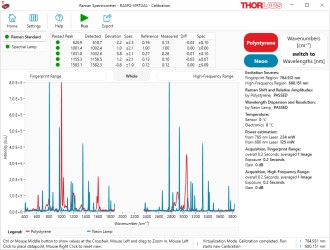
Click for Details
The ThorRaman Software allows for easy acquisition of Raman spectra and includes automatic analysis features. Shown here are the polystyrene and neon spectra acquired during system calibration of a RASP2 spectrometer.
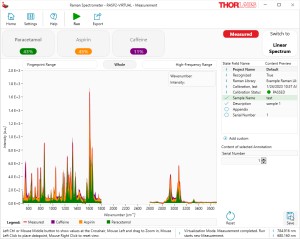
Click for Details
Spectral analysis shows the assignment of the measured peaks to the components of the selected library. Samples can be analyzed for up to four constituent substances.

Click for Details
The ThorRaman software features a library with a selection of different substances. To analyze substances not included in the Example Raman Library, the user can generate a custom library or edit existing custom ThorRaman libraries to include new substances.
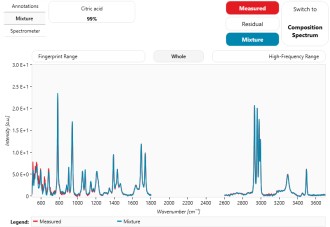
Click for Details
Raman spectra of citric acid acquired using the RASP2 spectrometer. Citric acid is an intermediate in the citric acid cycle, which occurs in the metabolism of all aerobic organisms.
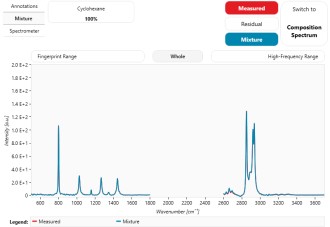
Click for Details
Raman spectra of cyclohexane acquired using the RASP2 spectrometer. Commonly used as a solvent, cyclohexane is a cycloalkane with the molecular formula C6H12.
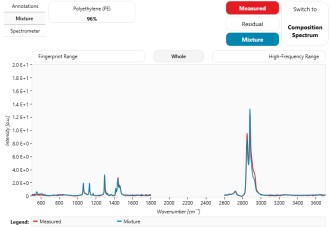
Click for Details
Raman spectra of polyethylene acquired using the RASP2 spectrometer. Polyethylene (PE) (polythene or poly(methylene)) is a polymer, primarily used for packaging.
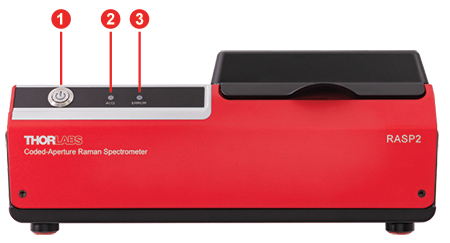
Click to Enlarge
Spectrometer Front Panel
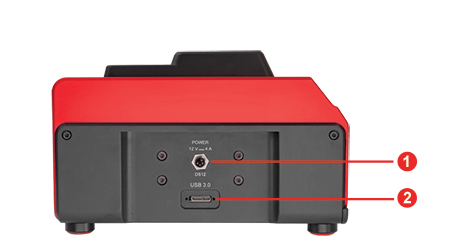
Click to Enlarge
Spectrometer Left Side Panel
| Front Panel | |
|---|---|
| Callout | Description |
| 1 | Power Button |
| 2 | Acquisition Status LED |
| 3 | Error Status LED |
| Side Panel | |
|---|---|
| Callout | Description |
| 1 | M8 Female Connector for 12 VDC (DS12 Power Connector) |
| 2 | USB 3.0 Micro B Port |
Shipping List
The following items are shipped with the RASP1 and RASP2 Portable Coded-Aperture Raman Spectrometers:
- Raman Spectrometer Instrument
- DS12 Power Supply
- Region-Specific Power Cord
- USB 3.0 A to Micro B Cable, 118" (3 m) Length
- RPC Polystyrene Calibration Chip
- Quick Reference
- Certificate of Calibration
The following items are shipped with the RASPA1 Sample Accessories Kit:
- Sample Adapter with Funnel and Cuvette Holder
- VFS1512 1.5 mL Fused Silica Vial, Ø12 mm
- VFS5021 5 mL Fused Silica Vial, Ø20.5 mm
- 3.5 mL Synthetic Quartz Glass Cuvette, 10 mm Path Length (2-Pack Replacement Item # CV10Q35FEP)
- MS10FS Fused Silica Precision Microscope Slide, 24.4 mm x 76.2 mm x 1.0 mm
- PLF1016 Fused Silica Glass Plate, Ø1", 1.6 mm Thick
- DSH20F Fused Silica Petri Dish, Ø20 mm x 6 mm
Coded-Aperture (CODA) Raman Spectroscopy
Thorlabs' Raman Spectrometers are based on an imaging spectrograph that features a diffraction grating as the dispersive element. Traditional spectrographs of this design face a trade-off between the desired spectral resolution and the achievable light throughput. This is because the dispersive element produces spectrally separable images of the same slit image. When the slit is wider, the light throughput may be increased, but the spectra may no longer be separable, leading to loss of the spectral information.
In contrast, Thorlabs' Raman spectrometers replace the single-slit input aperture of conventional systems with a defined pattern of multiple slits, which is known as a coded-aperture (CODA) input. This spatial amplitude modulation mask acts as a convolution operator with an orthogonal basis in two dimensions. The resulting mesh image from the sensor is reconstructed using the inverse transform operator. This encoding uses the complete large window of the mask for optical input, while the output spectral resolution is defined by dimensions of a single mask element.
The pure math engine of a Hadamard transform is adopted for the Raman spectroscopy application; please see the reference article for more details1. Hadamard matrices consist of elements that only take values of 1 and -1. Since the -1 element cannot be realized in a real-world mask, our pseudo-Hadamard optical mask maps the -1 to 1 values to intensity modulations from the range of 0 (light blocked) and 1 (pixel transparent). The necessary spectrum reconstruction algorithms are implemented in the supplied ThorRaman Software, as well as corrections for the unavoidable optical distortions due to a large input field.
These spectrometers employ a pseudo-Hadamard mask of order 64 as the aperture. With an aperture size of 2.3 mm x 3.2 mm, this spatial amplitude modulation mask improves light-throughput, or the system étendue, compared to a standard single-slit aperture, allowing enough Raman-scattered light to reach the CMOS sensor for room temperature operation. Increased étendue of the spectrograph's input also enables a larger spot size (Ø1 to Ø2 mm), which allows sample excitation with an unfocused laser beam. This is ideal for nonhomogeneous samples, such as powders and pills, that require an average over a large area to determine composition. An unfocused excitation beam also results in a lower power density, reducing the risk of laser-induced damage to the sample.
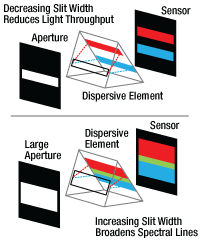
Click to Enlarge
Traditional imaging spectrographs require narrow slits to achieve high spectral resolution. This limits the light that can pass through the spectrograph.
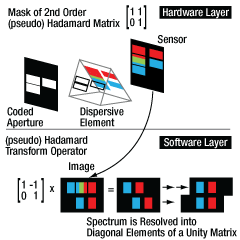
Click to Enlarge
A spectrograph with a coded aperture uses a slit pattern to increase light throughput while maintaining high spectral resolution. This example shows a Hadamard mask of order 2, while the mask used in RASP series spectrometers is order 64.
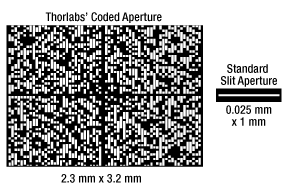
Click to Enlarge
Size comparison of the coded aperture and a standard slit aperture. The coded aperture is a pseudo-Hadamard mask of order 64; the white and dark areas represent where light is transmitted through the mask or blocked, respectively.
References
- M.E. Ghem et al., "Static Two-Dimensional Aperture Coding for Multimodal, Multiplex Spectroscopy," Applied Optics, vol. 45, no. 13, 2006.
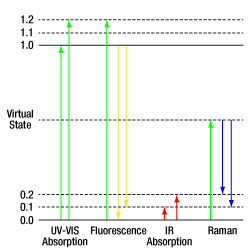
Click to Enlarge
Energy Levels of Various Radiation Types
Raman Spectroscopy
Raman Spectroscopy is a well-established technique for the characterization of chemical substances in solid, powder, liquid, or gas forms. It is based on the detection and analysis of Raman scattered light emitted from a sample upon exposure to monochromatic light.
Raman Scattering
Atoms in a molecule are held together by chemical bonds. Depending on the number of atoms and the geometry of the bonds, there are different ways molecules can vibrate. Each mode of vibration can be excited only with a certain, well defined amount of energy. When an exciting photon is absorbed by the molecule, it may excite a vibrational mode or absorb energy from an existing vibrational mode before being re-emitted. The loss or gain of energy due to this interaction with a vibrational mode means the photon is inelastically scattered, and this interaction between the light and the material is called the Raman effect. The resulting shift in energy and wavelength of the scattered photon due to this inelastic scattering (Raman scattering) is called the Raman shift. Raman spectroscopy measures this Raman shift.
Raman scattering is a rather rare event and occurs in only about 1 in 1 million exciting photons. It is, therefore, critical to excite the sample with a high-power light source and to collect as much Raman-scattered light as possible for analysis. To generate sufficient Raman scattering, the sample is typically exposed to high-intensity monochromatic laser light.
Because excitation of a whole set of vibrational states of a sample with a defined amount of energy (the exciting laser light) results in material-specific Raman scattering, a measured Raman spectrum may be considered a chemical fingerprint of the substance. The vibrations detected by Raman spectroscopy may differ from those modulating the molecular dipoles, which are observable by IR spectroscopy, and make it a valuable source for material analysis and complementary to other types of vibrational spectroscopy.
Energy Shift Due to Inelastic Scattering
Raman spectroscopy analyzes the shift in energy due to inelastic scattering caused by the Raman effect. The wavelength of the inelastically scattered photon is related to the excitation wavelength through the following energy equation describing the Raman scattering event:

where Evib is the vibrational energy of the molecule affected by the exciting photon, Eout is the energy of the scattered photon, and Ein is the energy of the exciting photon.
The photon's energy and frequency are related via the Planck-Einstein relation:

with h = 6.6260715 x 10-34 J⋅s, fin is the incoming photon frequency in Hertz. The analogous relation holds for the scattered photon (Eout = hfout).
Using equations 1 and 2, as well as λ=c/f where c is the speed of light, the Raman shift of a molecular vibration can be characterized with knowledge of the precise wavelength of the excitation wavelength λin based on the following equation:

Describing Raman scattering in wavelength space is a disadvantage, as it depends on the precise excitation wavelength. However, it is fixed in the Raman-shift scale, or wavenumber scale, in units of cm-1. Therefore, in order to compare Raman spectra of a substance between different experimental setups, Raman spectra are represented as 2D plots of measured relative intensity (Y-axis) in Raman shift of the inelastic scattered light in wavenumbers (cm-1, X-axis). This unit is, in contrast to nanometers, a scale proportional to energy.
Laser Safety and Classification
Safe practices and proper usage of safety equipment should be taken into consideration when operating lasers. The eye is susceptible to injury, even from very low levels of laser light. Thorlabs offers a range of laser safety accessories that can be used to reduce the risk of accidents or injuries. Laser emission in the visible and near infrared spectral ranges has the greatest potential for retinal injury, as the cornea and lens are transparent to those wavelengths, and the lens can focus the laser energy onto the retina.
Safe Practices and Light Safety Accessories
- Laser safety eyewear must be worn whenever working with Class 3 or 4 lasers.
- Regardless of laser class, Thorlabs recommends the use of laser safety eyewear whenever working with laser beams with non-negligible powers, since metallic tools such as screwdrivers can accidentally redirect a beam.
- Laser goggles designed for specific wavelengths should be clearly available near laser setups to protect the wearer from unintentional laser reflections.
- Goggles are marked with the wavelength range over which protection is afforded and the minimum optical density within that range.
- Laser Safety Curtains and Laser Safety Fabric shield other parts of the lab from high energy lasers.
- Blackout Materials can prevent direct or reflected light from leaving the experimental setup area.
- Thorlabs' Enclosure Systems can be used to contain optical setups to isolate or minimize laser hazards.
- A fiber-pigtailed laser should always be turned off before connecting it to or disconnecting it from another fiber, especially when the laser is at power levels above 10 mW.
- All beams should be terminated at the edge of the table, and laboratory doors should be closed whenever a laser is in use.
- Do not place laser beams at eye level.
- Carry out experiments on an optical table such that all laser beams travel horizontally.
- Remove unnecessary reflective items such as reflective jewelry (e.g., rings, watches, etc.) while working near the beam path.
- Be aware that lenses and other optical devices may reflect a portion of the incident beam from the front or rear surface.
- Operate a laser at the minimum power necessary for any operation.
- If possible, reduce the output power of a laser during alignment procedures.
- Use beam shutters and filters to reduce the beam power.
- Post appropriate warning signs or labels near laser setups or rooms.
- Use a laser sign with a lightbox if operating Class 3R or 4 lasers (i.e., lasers requiring the use of a safety interlock).
- Do not use Laser Viewing Cards in place of a proper Beam Trap.
Laser Classification
Lasers are categorized into different classes according to their ability to cause eye and other damage. The International Electrotechnical Commission (IEC) is a global organization that prepares and publishes international standards for all electrical, electronic, and related technologies. The IEC document 60825-1 outlines the safety of laser products. A description of each class of laser is given below:
| Class | Description | Warning Label |
|---|---|---|
| 1 | This class of laser is safe under all conditions of normal use, including use with optical instruments for intrabeam viewing. Lasers in this class do not emit radiation at levels that may cause injury during normal operation, and therefore the maximum permissible exposure (MPE) cannot be exceeded. Class 1 lasers can also include enclosed, high-power lasers where exposure to the radiation is not possible without opening or shutting down the laser. |  |
| 1M | Class 1M lasers are safe except when used in conjunction with optical components such as telescopes and microscopes. Lasers belonging to this class emit large-diameter or divergent beams, and the MPE cannot normally be exceeded unless focusing or imaging optics are used to narrow the beam. However, if the beam is refocused, the hazard may be increased and the class may be changed accordingly. |  |
| 2 | Class 2 lasers, which are limited to 1 mW of visible continuous-wave radiation, are safe because the blink reflex will limit the exposure in the eye to 0.25 seconds. This category only applies to visible radiation (400 - 700 nm). |  |
| 2M | Because of the blink reflex, this class of laser is classified as safe as long as the beam is not viewed through optical instruments. This laser class also applies to larger-diameter or diverging laser beams. |  |
| 3R | Class 3R lasers produce visible and invisible light that is hazardous under direct and specular-reflection viewing conditions. Eye injuries may occur if you directly view the beam, especially when using optical instruments. Lasers in this class are considered safe as long as they are handled with restricted beam viewing. The MPE can be exceeded with this class of laser; however, this presents a low risk level to injury. Visible, continuous-wave lasers in this class are limited to 5 mW of output power. |  |
| 3B | Class 3B lasers are hazardous to the eye if exposed directly. Diffuse reflections are usually not harmful, but may be when using higher-power Class 3B lasers. Safe handling of devices in this class includes wearing protective eyewear where direct viewing of the laser beam may occur. Lasers of this class must be equipped with a key switch and a safety interlock; moreover, laser safety signs should be used, such that the laser cannot be used without the safety light turning on. Laser products with power output near the upper range of Class 3B may also cause skin burns. |  |
| 4 | This class of laser may cause damage to the skin, and also to the eye, even from the viewing of diffuse reflections. These hazards may also apply to indirect or non-specular reflections of the beam, even from apparently matte surfaces. Great care must be taken when handling these lasers. They also represent a fire risk, because they may ignite combustible material. Class 4 lasers must be equipped with a key switch and a safety interlock. |  |
| All class 2 lasers (and higher) must display, in addition to the corresponding sign above, this triangular warning sign. |  |
|
| Posted Comments: | |
| No Comments Posted |

Recommended Accessories (Sold Separately)
- RASPA1 Sample Accessories Kit
For the full list of accessories shipped with the spectrometers and RASPA1 kit, please see the Shipping List tab.
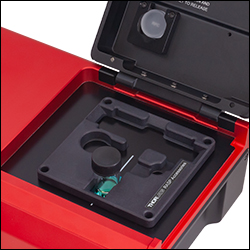
Click to Enlarge
Container Holder and 5 mL Vial from the
RASPA1 Accessory Kit Shown in
RASP2 Spectrometer's Sample Compartment
- Imaging Spectrometer with a 2.3 mm x 3.2 mm Coded Aperture
- Integrated Excitation Laser(s)
- RASP1 Spectrometer: 785 nm Laser (Fingerprint Region)
- RASP2 Spectrometer: 785 nm & 680 nm Lasers (Fingerprint and High Frequency Regions)
- Amplitude Corrected using a NIST-Certified Polynomial (NIST SRM2241)
- User Calibration of Wavelength/Wavenumber using Included RPC Calibration Chip and Internal Neon Lamp
- Sample Compartment Easily Cleanable
RASP Series Raman Spectrometers are portable systems ideal for detecting low-intensity Raman signals. Two models are available: the RASP1 spectrometer includes a 785 nm laser for the fingerprint region (500 cm-1 to 1800 cm-1), while the RASP2 spectrometer also includes a supplemental 680 nm laser for the high frequency region (2600 cm-1 to 3700 cm-1). In addition to integrated lasers, each system also features an imaging spectrograph with a volume-holographic grating and a large coded-aperture (CODA) input for increased light throughput. Safety interlocks prevent exposure to the internal Class 4 laser(s), lowering the system's laser classification to Class 1.
Software
These spectrometers use the ThorRaman software to record spectra, which can be downloaded from ThorRaman Software page. See the Software tab for a list of recommended system requirements. Each system is shipped with a USB 3.0 cable to connect the system to a PC (not included). System power is provided via the included 12 VDC power supply.
Amplitude Correction & Calibration
The components of the spectrograph, such the grating and detector, have wavelength-dependent efficiencies. To compensate for this, the spectrograph is amplitude corrected using a NIST SRM2241 certified standard during factory calibration, which ensures compatibility of acquired spectra and custom libraries with external databases and other RASP series spectrometers. User calibration is performed using the included RPC polystyrene chip and an internal neon lamp.
Sample Containers and Accessory Kit
Small solid samples may be placed directly on the sample window. Since liquids and powders may contaminate the system, glass containers must be used. The RASPA1 accessory kit (sold separately below) includes a variety of fused silica and quartz containers, as well as polyamide holders to position and align the samples within the detection volume for optimal Raman scattering and detection. Additional containers may also be purchased separately below.
To clean the inside of the sample compartment, use a slightly wet cloth and, if necessary, a small amount of soap. Do not use an excess amount of liquid as it may contaminate the inside of the system.

| RASPA1 Accessory Kit Contents | ||
|---|---|---|
| Item # | Callouta | Description |
| VFS1512 | 1 | 1.5 mL Vial, Ø12 mm, Fused Silica |
| VFS5021 | 2 | 5 mL Vial, Ø20.5 mm, Fused Silica |
| CV10Q35FEPb | 3b | 3.5 mL Cuvette, Synthetic Quartz Glass |
| MS10FS | 4 | Microscope Slide, 1 mm Thick, Fused Silica |
| PLF1016 | 5 | Ø1" Glass Plate, 1.6 mm Thick, Fused Silica |
| DSH20F | 6 | 1 mL Petri Dish, Ø20 mm x 6 mm, Fused Silica |
| - | 7 | Four-Orientation Container Holderc |
| - | 8 | Sample Funnel Insertc |
| - | 9 | Cuvette Holder Insertc |
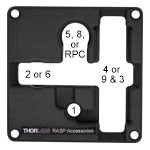
Click for Details
Container Holder Options
- RASPA1 Accessory Kit Includes Sample Containers and Holders
- Sample Containers Made of Fused Silica or Synthetic Quartz Glass
- Holders and Funnel Insert Made of PA 2241 FR Polyamide
- Sample Containers Also Available Individually
- CV10Q35FEP Cuvettes Shipped in Packs of Two
The RASPA1 sample container accessory kit includes the items listed in the table to the right. A four-orientation container holder, cuvette holder insert, and sample funnel insert (all manufactured from robust PA 2241 FR polyamide) are included which mount onto the sample compartment of the spectrometers sold above. In the appropriate orientation (see the photo to the left or the spectrometer manual for details), the large holder positions containers directly at the correct alignment for optimal excitation and detection of Raman scattering.
Alternatively, drawing files for a blank sample holder template are provided here, which can be used as the basis to design and 3D print custom sample holders for the Raman systems. The laser beam path is indicated by a cutout to indicate optimal placement when creating the cutout for the sample container.
Each glass container and accessory is made of fused silica or synthetic quartz glass and is also available for purchase separately. The septa in the caps included with the vials and cuvette are made of PTFE.

- RPC Ø1" Polystyrene Chip: Replacement for Chip Included with Each RASP Series Spectrometer
- RPB Polystyrene Block: Alternate Calibration Sample in Cuvette Form Factor
The RPC polystyrene chip and RPB polystyrene block may be used with RASP Series Raman Spectrometers as replacement calibration samples. One RPC polystyrene chip is included with each RASP Series Raman Spectrometer.
 Products Home
Products Home









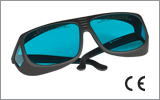
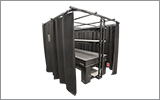
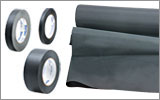

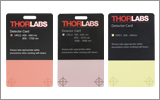
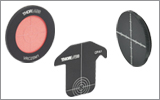
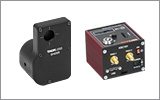
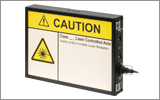

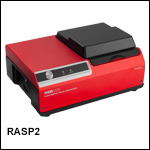
 Zoom
Zoom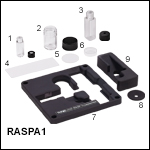
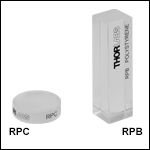
 Portable Raman Spectrometers
Portable Raman Spectrometers